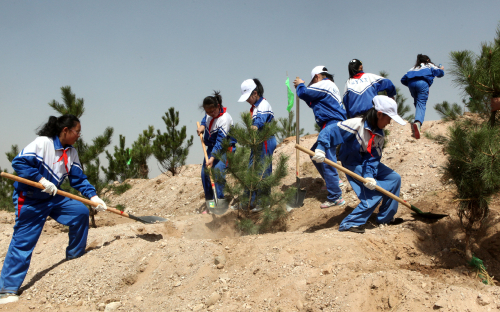|
 |
|
A MOUNTAINOUS EFFORT: Students plant trees at Wolong Mountain, Wanquan County, north China's Hebei Province, on April 9 (GONG ZHIHONG) |
However, since China has become the biggest carbon emitter and the second largest economy in the world, some foreign experts and media tend to categorize the nation as a developed country and pressure it to shoulder as much responsibility as the developed world in coping with climate change.
"It's an indisputable fact that China is a developing country, which can be easily proved by every aspect of Chinese people's life. For example, the per-capita meat consumption in China's urban area is roughly 60 kg annually, far less than the 120 kg in developed countries, which mirrors its weak agricultural industry and low production efficiency," said Gao Feng, Special Representative for Climate Change Negotiations, stating his opinion that developed countries always feature strong agriculture.
"Now, the gap between developed countries and developing countries is still very big, and economic growth, social development and poverty elimination are still the main tasks of the developing countries. After 2020, the developing countries will still lag far behind the developed countries in terms of national conditions, development stages and actual ability," said Su Wei, head of the Climate Change Department of the NDRC, explaining why the common but differentiated responsibilities principle is necessary.
As a matter of fact, when many developed countries reached their carbon dioxide emission peaks, China was far from the biggest emitter, said Gao, indicating that the current problems concerning climate change are mainly a result of the unrestrained emissions of developed countries in the past.
According to the UNFCCC, developed countries should fulfill the obligations of providing sufficient funds for developing countries to cope with climate change. However, the funding negotiations, including those for technology transfer, have made little progress over the past two decades.
At the 2009 Copenhagen conference, developed countries promised to provide $100 billion a year by 2020 to the developing world. By now, the Green Climate Fund under the UNFCCC has only raised a little more $9 billion.
Substantial contributions
Following the Asia-Pacific Economic Cooperation meetings in Beijing in November, China and the United States issued a joint statement on climate change to limit greenhouse gas emissions.
According to the statement, the United States has set a target of reducing its emissions by 26 to 28 percent below its 2005 level in 2025, while China has pledged to achieve the peaking of carbon dioxide emissions around 2030 and increase the share of non-fossil fuels in primary energy consumption to around 20 percent by 2030.
UN Secretary General Ban Ki-moon commended the statement, calling it "an important contribution" to a possible agreement at a UN climate conference in Paris in 2015.
According to the agreement reached at the Warsaw climate conference in November 2013, all countries should release their targets in the first quarter of 2015. "China and the United States, the two major greenhouse gas emitting countries, have already released their targets ahead of the schedule, which clearly illustrates China's attitude toward promoting a multi-lateral process," said Xie.
Since the two countries are at different development stages, their goals are differentiated—China's goal is about relative emission reduction, while the United States has to cut its absolute volume. Xie suggested that China should be likely to maintain the level for years after reaching its carbon dioxide emission peak, following the experience of many developed countries.
At the UN Climate Summit held in September, Vice Premier Zhang Gaoli, special envoy of President Xi Jinping, proposed China's post-2020 action goal to deal with climate change—reducing carbon intensity, increasing the share of non-fossil fuels, raising the forest stock, and reaching the peak of its total carbon dioxide emission as early as possible. Beyond that, Zhang announced that China would double its investment in the South-South Cooperation Fund.
| 